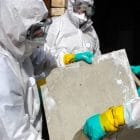What does Asbestos Insulation look like?
While owning an older home is pretty special, it sometimes has hidden surprises—like asbestos. While most of us are aware of asbestos, we still believe it is not taken as seriously as it should be…
This stuff used to be everywhere, especially in roof insulation, threatening to impact you and your family if disturbed. So, how do you make sure your home is asbestos-free? The first step is identifying that asbestos may be present in your property. How? By understanding the many forms and types of asbestos hiding on your property. Let’s delve into one of the most common forms of asbestos in Australian homes – Insulation. What is asbestos insulation, what does it look like, and where might it lurk in my house? Don’t worry, Ryno’s Asbestos Removal is here to help! We’ll shed some light on this whole asbestos mystery and get you the necessary answers to protect you and your loved ones.
What is asbestos insulation?
Asbestos isn’t just hiding in roof insulation; it sneaks into walls and ceilings, too! One culprit is an asbestos insulating board (also known as LDB)… a flat or perforated board with asbestos fibres mixed in with plaster. Sounds fun, right? Not quite…. This stuff was popular in the 50s to 70s for soundproofing, but—just like other asbestos—it’s a serious health hazard if disturbed.
Why is asbestos insulation toxic?
Inhaling those tiny asbestos fibres can be very dangerous to your health, potentially leading to incurable cancers like mesothelioma. The scary part? Asbestos is seemingly harmless when not disturbed in your walls or ceiling. But if you mess with it—such as during renovations—those fibres can get released, and that’s when things get risky. The good news? Undisturbed asbestos is generally low-risk. The key is knowing what to look for and leaving any potential asbestos concerns to the pros at Ryno’s Asbestos Removal!
What does asbestos insulation look like?
What about identifying asbestos insulation specifically? While asbestos can be tricky to pinpoint by sight alone, there are some tell-tale signs to watch for with an asbestos insulating board (LDB). Vermiculite insulation is one of the most common forms of asbestos insulation, which has a pebble-like appearance and is typically greyish-brown or silvery-gold in colour. While this is true, identifying asbestos insulation from sight alone can be extremely difficult. View our further tips below to help you become an Asbesots mastermind!
Asbestos Insulation: Signs to Look For:
Check the Backstory: If your home was built between the 1950s and 1970s, that’s a red flag for potential LDB. This was once extremely popular for soundproofing.
Label Check: Sometimes LDB has a brand name on the back, like Duralux or Asbestolux. But just because there’s no label doesn’t mean you’re in the clear. LDB could also be hidden as plain ceiling tiles.
Bend and Snap: LDB tends to be flexible and will tear rather than snap under pressure. Broken edges tend to look ragged or fuzzy, almost like they have fur.
Fastener: Since LDB is soft, the heads of nails and other fasteners are often embedded or sunken into the surface.
Joining the Dots: The edges of LDB might be slanted, bevelled, or hand-planed, creating a V-joint when two pieces come together.
While LDB is common, asbestos insulation can appear in various places throughout your home. Here’s a quick rundown:
Attics and Ceilings: Loose insulation or popcorn ceilings (yep, the kind that looks like popcorn!) could contain asbestos. Ceiling tiles are another potential culprit.
Roofs: Corrugated asbestos sheets were commonly used for roofs. Important safety note: these roofs are brittle and could be dangerous to walk on.
Walls: Asbestos cement sheets or LDB might have been used on walls for fireproofing.
Eaves and Gables: The eaves (under the roof overhang) and gables (the triangular part at the end of the roof) could also contain asbestos.
Ductwork and Air Conditioning: Gasket building materials around ductwork joints and insulation around heating elements in air conditioners might contain asbestos.
Remember: This list isn’t exhaustive, and if you suspect asbestos fibers anywhere in your home, don’t play detective! While looking is still key, always keep in mind touching is a big no-no! Our advice? If your home was built earlier than the 90s, call Ryno’s for a professional and reliable testing service.
Remember, the only way to 100% identifies asbestos is through a professional testing service. Don’t take the risk if you have any doubt that Asbestos is in your home! Test your home and live with the peace of mind that you have done your part in keeping yourself and your loved ones safe and sound.
Get a Professional Asbestos Test with Ryno’s:
We know what you’re thinking—with all these signs to look for, can’t I just identify asbestos myself? Here’s the truth: while the points above can be helpful, visual confirmation alone isn’t reliable. For complete peace of mind (and a good night’s sleep!), Ryno strongly recommends professional asbestos testing.
Our certified professionals are trained in safe asbestos handling, and we use NATA-accredited laboratories for testing. This means you’ll get clear, reliable results within days, not weeks. Plus, we’ll walk you through every step of the process and answer any questions you have in plain English.
Don’t let the fear of asbestos exposure keep you up at night. If you suspect it lurking in your home, contact Ryno’s Asbestos Removal today for a free consultation and quote on asbestos testing. Let’s turn worry into knowledge and keep your home safe and healthy!


